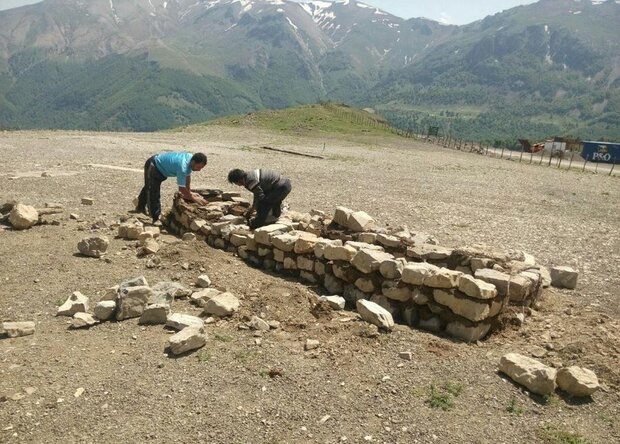Archaeologists hope to shed new light on human life in Masouleh

TEHRAN – Archaeologists have commenced work to discover fresh evidence on human life in the touristic village of Masouleh and its surroundings in northern Iran.
“It is the third archaeological season being carried out here in Masuleh. Previous seasons held in 1370 (1991) and 1391 (2012) yielded artifacts belonging to the fifth to eighth centuries AH,” Gilan province’s tourism chief Vali Jahani said on Saturday.
Iran is hoping to win a UNESCO recognition for Masuleh. According to the UN cultural body, the existence of numerous graveyards inner and outside of the city proves its old texture. The picturesque village is famed for its Lego-shaped earthen houses built on another’s rooftop.
“Remains of residential buildings, smelting workshops, tools for the extraction and manufacture of metal objects (Challangari), and glazed potteries related to the Seljuk era (1037–1194) were found in previous excavations,” the official said.
“The present archaeological season seeks to obtain additional information about the approximate extent of Old Masuleh, to unearth ancient artifacts, and to explore possible reasons for the migration of its inhabitants to the current village.”
According to the available documents, the earthquake of 890 AH and the outbreak of the plague in 943 AH were possible reasons for the migration of the ancient people of Masoleh to the current location of this historic village, Jahani explained.
Newly-found archaeological evidence indicates the history of human presence in mountains near Masouleh dates back to the late Bronze Age (2000-1500 BC), which is extremely older than previously believed.

Archaeological research held last year concluded that human beings resided in these highlands seasonally, at least since the late Bronze Age. The survey was carried out as part of a preliminary process to compile an all-inclusive dossier for the touristic village to be presented to the United Nations Educational, Scientific, and Cultural Organization.
Jahani has said: “These new findings would help us to complete the Archaeological Atlas of the western part of Gilan, especially in the highlands of Alborz.”
Results of that preliminary survey suggested that the mountainous landscape was probably occupied by ancient herders and nomads at least since the late Bronze Age. Moreover, the survey found remains of late prehistoric, historic, and Islamic times were recorded on the mountain top above 2500 meters above sea level.
Gilan is well-known for its rich Iron Age cemeteries such as Marlik that have been excavated over the past century. It was once within the sphere of influence of the successive Achaemenian, Seleucid, Parthian, and Sassanid empires that ruled Iran until the 7th century CE. The subsequent Arab conquest of Iran led to the rise of many local dynasties, and Gilan acquired an independent status that continued until 1567.
According to Freidoun Biglari, a Paleolithic archaeologist of the National Museum of Iran, the discovery of stone artifacts on these highlands indicates that the area was seasonally visited by prehistoric human groups. He added that archaeological evidence found in other parts of Gilan, such as Darband Rashi Cave, shows that the western half of the Alborz range has been inhabited by Paleolithic hunter-gatherer groups, since the Lower Paleolithic period.
“Therefore, considering the existence of numerous caves and suitable stone raw resources in the study area, we expect to find more definitive archaeological evidence of the Paleolithic occupation of the Masouleh region,” Biglari explained.
Home to some of the most stunning landscapes in the country, Masouleh is one of the many stepped villages that are quite common to find around the country, especially in Iranian Kurdistan and around Mashhad. They have been built on a hill so steep that the roof of one house is the pathway for the next.
Whereas practically, all stepped villages in Iran have been able to keep their rural and traditional essence, for some reason, Masouleh has evolved into a popular touristic destination that especially attracts domestic vacationers.
Foreigners are less common though, basically because it is far away from the classic Persian route, so most tourists don’t have the time to travel that deep into the country.
According to experts, Masouleh is receiving the attention of all the guidebooks, portraying it as a dreamy mountain village so, slowly, it is becoming the prime destination for those travelers who have a little more than two weeks in Iran.
The village is pretty, composed of some yellowish houses which disappear behind the mist during the early morning hours. Being the most visited stepped village in Iran, Masouleh has all types of opinions. On the one hand, the most well-traveled backpackers will tell you that Masouleh is not worth the journey unless you don’t mind eating in overpriced restaurants or trying to bargain ridiculous fares with taxi drivers. On the other hand, less demanding travelers will tell you that Masouleh is such a lovely village that you can’t miss.
Surrounded by green valleys, misty forests, and 3,000m peaks, Masouleh is the ultimate trekking destination in Iran, offering several trails that include both day treks and multi-day treks. Along the way, you are likely to find quite a few Iranian shepherds who live there, perhaps not in winter, but they have fully equipped shacks and you are likely to be invited to have some chai (tea).
Close to the peak, the landscape turns from misty forests to vast green, gorgeous meadows covered in blankets of flowers, a stream, and a few more shepherd shacks, like in a fairy tale. Visitors can find both expensive hotels and budget guesthouses. To find a homestay, you just need to walk around town and someone will approach you.
AFM
Leave a Comment